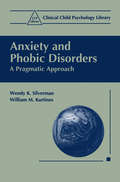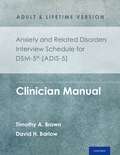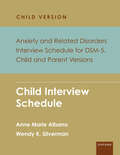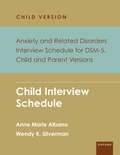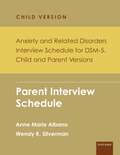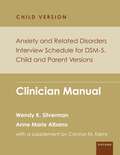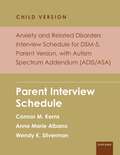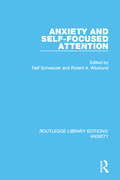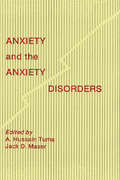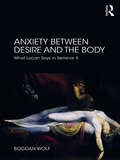- Table View
- List View
Anxiety and Phobic Disorders: A Pragmatic Approach (Clinical Child Psychology Library)
by Wendy K. Silverman Wiliam M. KurtinesFor many years, anxiety and phobie disorders ofchildhoodand adolescence were ignored by clinicians and researchers alike. They were viewed as largely benign, as problems that were relatively mild, age-specific, and transitory. With time, it was thought, they would simply disappear or "go away"-that the child or adolescent would magically "outgrow" them with development and that they would not adversely affect the growing child or adolescent. As a result ofsuch thinking, it was concluded that these "internalizing" problems were not worthy or deserving of our concerted and careful attention-that other problems of childhood and adolescence and, in particular, "externalizing" problems such as conduct disturbance, oppositional defiance, and attention-deficit problems de manded our professional energies and resources. These assumptions and asser tions have been challenged vigorously in recent years. Scholarly books (King, Hamilton, & Ollendick, 1988; Morris & Kratochwill, 1983) have documented the considerable distress and misery associated with these disorders, while reviews ofthe literature have demonstrated that these disorders are anything but transitory; for a significant number of youth these problems persist into late adolescence and adulthood (Ollendick & King, 1994). Clearly, such findings signal the need for treatment programs that "work"--programs that are effective in the short term and efficacious over the long haul, producing effects that are durable and generalizable, as weil as effects that enhance the life functioning of children and adolescents and the families that evince such problems.
Anxiety and Related Disorders Interview Schedule for DSM-5: Client Interview Schedule 5-Copy Set (Treatments That Work)
by David H. Barlow Timothy A. BrownThe Anxiety and Related Disorders Interview Schedule for DSM-5?: Adult Version (ADIS-5) is a structured interview designed to diagnose current anxiety, mood, obsessive-compulsive, trauma, and related disorders (e.g., somatic symptom, substance use) and to permit differential diagnosis among these disorders according to DSM-5? criteria (American Psychiatric Association, 2013). In most diagnostic sections, the ADIS-5 also provides: (a) dimensional assessment of the key and associated features of disorders; and (b) inquiry to foster the functional analysis of the various disorders (e.g., nature of situations avoided, content of fear cognitions). The ADIS-5 contains screening questions for a variety of other conditions including hoarding disorder, impulse control disorders, eating disorders, attention deficit disorder, dissociative disorders, and psychotic disorders. Other sections of the ADIS-5 include the assessment of episodic and ongoing life stress, medical and psychiatric treatment history, and familial psychiatric history.
Anxiety and Related Disorders Interview Schedule for DSM-5®: Clinician Manual (Treatments That Work)
by Timothy A. Brown David H. BarlowThe Anxiety and Related Disorders Interview Schedule for DSM-5® (ADIS-5) Clinician Manual accompanies both the Adult and Lifetime versions of the ADIS-5 Client Interview Schedules. The interview schedules are designed to diagnose anxiety, mood, obsessive-compulsive, trauma, and related disorders (e.g., somatic symptom, substance use) and to permit differential diagnosis among these disorders according to DSM-5® criteria (American Psychiatric Association, 2013). The Clinician Manual provides information for the clinician about uses of the ADIS-5, changes introduced in the ADIS-5, coverage of the ADIS-5, organization of diagnostic sections, how to administer the ADIS-5, and more.
Anxiety and Related Disorders Interview Schedule for DSM-5, Child and Parent Version: Child Interview Schedule - 5 Copy Set (PROGRAMS THAT WORK)
by Anne Marie Albano Wendy K. SilvermanThe Anxiety Disorders Interview Schedule for DSM-5, Child and Parent Versions, are the gold standard semi-structured interviews used in clinical research and services to assess and diagnose the major mental health conditions affecting children, adolescents and young adults. These interviews cover the range of conditions identified in the Diagnostic and Statistical Manual of Mental Disorders (DSM), while also providing information for careful case formulation in treatment planning and evaluation of outcomes. Evaluators are able to quantify the severity of illness using a Clinician Severity Rating (CSR), as well as level of severity of symptoms and associated avoidance behavior. Decision rules for combining parent and youth reports, examples of CSR levels for the child anxiety triad of separation anxiety disorder, social anxiety disorder, and generalized anxiety disorder are included in the Clinician Guide. Price is for a set of 5 Child Interview Schedules.
Anxiety and Related Disorders Interview Schedule for DSM-5, Child and Parent Version: Child Interview Schedule - 5 Copy Set (PROGRAMS THAT WORK)
by Anne Marie Albano Wendy K. SilvermanThe Anxiety Disorders Interview Schedule for DSM-5, Child and Parent Versions, are the gold standard semi-structured interviews used in clinical research and services to assess and diagnose the major mental health conditions affecting children, adolescents and young adults. These interviews cover the range of conditions identified in the Diagnostic and Statistical Manual of Mental Disorders (DSM), while also providing information for careful case formulation in treatment planning and evaluation of outcomes. Evaluators are able to quantify the severity of illness using a Clinician Severity Rating (CSR), as well as level of severity of symptoms and associated avoidance behavior. Decision rules for combining parent and youth reports, examples of CSR levels for the child anxiety triad of separation anxiety disorder, social anxiety disorder, and generalized anxiety disorder are included in the Clinician Guide. Price is for a set of 5 Child Interview Schedules.
Anxiety and Related Disorders Interview Schedule for DSM-5, Child and Parent Version: Parent Interview Schedule - 5 Copy Set (PROGRAMS THAT WORK)
by Anne Marie Albano Wendy K. SilvermanThe Anxiety Disorders Interview Schedule for DSM-5, Child and Parent Versions, are the gold standard semi-structured interviews used in clinical research and services to assess and diagnose the major mental health conditions affecting children, adolescents and young adults. These interviews cover the range of conditions identified in the Diagnostic and Statistical Manual of Mental Disorders (DSM), while also providing information for careful case formulation in treatment planning and evaluation of outcomes. Evaluators are able to quantify the severity of illness using a Clinician Severity Rating (CSR), as well as level of severity of symptoms and associated avoidance behavior. Decision rules for combining parent and youth reports, examples of CSR levels for the child anxiety triad of separation anxiety disorder, social anxiety disorder, and generalized anxiety disorder are included in the Clinician Guide. Price is for a set of 5 Parent Interview Schedules.
Anxiety and Related Disorders Interview Schedule for DSM-5, Child and Parent Version: Parent Interview Schedule - 5 Copy Set (PROGRAMS THAT WORK)
by Anne Marie Albano Wendy K. SilvermanThe Anxiety Disorders Interview Schedule for DSM-5, Child and Parent Versions, are the gold standard semi-structured interviews used in clinical research and services to assess and diagnose the major mental health conditions affecting children, adolescents and young adults. These interviews cover the range of conditions identified in the Diagnostic and Statistical Manual of Mental Disorders (DSM), while also providing information for careful case formulation in treatment planning and evaluation of outcomes. Evaluators are able to quantify the severity of illness using a Clinician Severity Rating (CSR), as well as level of severity of symptoms and associated avoidance behavior. Decision rules for combining parent and youth reports, examples of CSR levels for the child anxiety triad of separation anxiety disorder, social anxiety disorder, and generalized anxiety disorder are included in the Clinician Guide. Price is for a set of 5 Parent Interview Schedules.
Anxiety and Related Disorders Interview Schedule for DSM-5, Child and Parent Version: Clinician Manual (PROGRAMS THAT WORK)
by Wendy K. Silverman Anne Marie AlbanoThe Anxiety Disorders Interview Schedule for DSM-5, Child and Parent Versions, are the gold standard semi-structured interviews used in clinical research and services to assess and diagnose the major mental health conditions affecting children, adolescents and young adults. These interviews cover the range of conditions identified in the Diagnostic and Statistical Manual of Mental Disorders (DSM), while also providing information for careful case formulation in treatment planning and evaluation of outcomes. Evaluators are able to quantify the severity of illness using a Clinician Severity Rating (CSR), as well as level of severity of symptoms and associated avoidance behavior. Decision rules for combining parent and youth reports, examples of CSR levels for the child anxiety triad of separation anxiety disorder, social anxiety disorder, and generalized anxiety disorder are included in the Clinician Guide, as well as detailed information on use of the Autism Supplement. This item includes one Clinician Manual.
Anxiety and Related Disorders Interview Schedule for DSM-5, Child and Parent Version: Clinician Manual (PROGRAMS THAT WORK)
by Wendy K. Silverman Anne Marie AlbanoThe Anxiety Disorders Interview Schedule for DSM-5, Child and Parent Versions, are the gold standard semi-structured interviews used in clinical research and services to assess and diagnose the major mental health conditions affecting children, adolescents and young adults. These interviews cover the range of conditions identified in the Diagnostic and Statistical Manual of Mental Disorders (DSM), while also providing information for careful case formulation in treatment planning and evaluation of outcomes. Evaluators are able to quantify the severity of illness using a Clinician Severity Rating (CSR), as well as level of severity of symptoms and associated avoidance behavior. Decision rules for combining parent and youth reports, examples of CSR levels for the child anxiety triad of separation anxiety disorder, social anxiety disorder, and generalized anxiety disorder are included in the Clinician Guide, as well as detailed information on use of the Autism Supplement. This item includes one Clinician Manual.
Anxiety and Related Disorders Interview Schedule for DSM-5, Child and Parent Version, with Autism Spectrum Addendum: Parent Interview Schedule - 5 Copy Set (PROGRAMS THAT WORK)
by Connor M. Kerns Anne Marie Albano Wendy K. SilvermanThe Anxiety Disorders Interview Schedule for DSM-5, Child and Parent Versions, are the gold standard semi-structured interviews used in clinical research and services to assess and diagnose the major mental health conditions affecting children, adolescents and young adults. These interviews cover the range of conditions identified in the Diagnostic and Statistical Manual of Mental Disorders (DSM), while also providing information for careful case formulation in treatment planning and evaluation of outcomes. Evaluators are able to quantify the severity of illness using a Clinician Severity Rating (CSR), as well as level of severity of symptoms and associated avoidance behavior. Decision rules for combining parent and youth reports, examples of CSR levels for the child anxiety triad of separation anxiety disorder, social anxiety disorder, and generalized anxiety disorder are included in the Clinician Guide, as well as detailed information on use of the Autism Supplement. Price is for a set of 5 Parent Interview Schedules with Autism Spectrum Addendum.
Anxiety and Related Disorders Interview Schedule for DSM-5, Child and Parent Version, with Autism Spectrum Addendum: Parent Interview Schedule - 5 Copy Set (PROGRAMS THAT WORK)
by Connor M. Kerns Anne Marie Albano Wendy K. SilvermanThe Anxiety Disorders Interview Schedule for DSM-5, Child and Parent Versions, are the gold standard semi-structured interviews used in clinical research and services to assess and diagnose the major mental health conditions affecting children, adolescents and young adults. These interviews cover the range of conditions identified in the Diagnostic and Statistical Manual of Mental Disorders (DSM), while also providing information for careful case formulation in treatment planning and evaluation of outcomes. Evaluators are able to quantify the severity of illness using a Clinician Severity Rating (CSR), as well as level of severity of symptoms and associated avoidance behavior. Decision rules for combining parent and youth reports, examples of CSR levels for the child anxiety triad of separation anxiety disorder, social anxiety disorder, and generalized anxiety disorder are included in the Clinician Guide, as well as detailed information on use of the Autism Supplement. Price is for a set of 5 Parent Interview Schedules with Autism Spectrum Addendum.
Anxiety and Self-Focused Attention (Routledge Library Editions: Anxiety)
by Ralf Schwarzer Robert A. WicklundFirst published in 1991, this book consists of 13 articles that were originally published in the journal Anxiety Research. They address the topic of anxiety and self-focused attention from a variety of perspectives, representing recent advances in social, clinical and personality psychology at the time. As a whole, the book poses a stimulating theoretical challenge to traditional anxiety research, which had been dominated by psychometric issues, clinical case studies and stable personality constructs. The contributors share the view that anxiety is an emotional state of distress dependent upon specific antecedent cognitive processes such as self-awareness, perceived role discrepancy or unfavourable expectancies.
Anxiety and Self-Focused Attention (Routledge Library Editions: Anxiety)
by Ralf Schwarzer Robert A. WicklundFirst published in 1991, this book consists of 13 articles that were originally published in the journal Anxiety Research. They address the topic of anxiety and self-focused attention from a variety of perspectives, representing recent advances in social, clinical and personality psychology at the time. As a whole, the book poses a stimulating theoretical challenge to traditional anxiety research, which had been dominated by psychometric issues, clinical case studies and stable personality constructs. The contributors share the view that anxiety is an emotional state of distress dependent upon specific antecedent cognitive processes such as self-awareness, perceived role discrepancy or unfavourable expectancies.
Anxiety and Stress Management (Routledge Library Editions: Anxiety #3)
by Trevor J. Powell Simon J. EnrightMost stress is a normal part of daily life, and can be coped with adequately by the individual. Prolonged or more serious stress however may require professional help. A local GP can often provide this but in many cases will refer the client to a mental health worker or other health professional. Originally published in 1990, this title was written for each of these groups: as a practical handbook and guide for those professionals working in the field of mental health, but also written for the referring GP and those seeking help themselves. The authors integrate theoretical and academic material relating to anxiety and stress research with clinical experience. The book begins with a theoretical section offering a working model of stress, a guide to diagnostic classification, and alternative models of anxiety. This is followed by chapters on assessment, explaining the problem and treatment procedures to the client, teaching specific self-help skills, and changing stressful lifestyles. Advice is also given on running anxiety and stress management groups, and individual case studies are examined. The authors make extensive use of analogy and metaphor to ensure ready understanding and recall. They also include many useful inventories, questionnaires, charts and client handouts. Anxiety and Stress Management will be of use to all health professionals working with people who have anxiety and stress related problems, but will prove equally valuable for the clients themselves as a reference book and as a means of self-education and self-help.
Anxiety and Stress Management (Routledge Library Editions: Anxiety #3)
by Trevor J. Powell Simon J. EnrightMost stress is a normal part of daily life, and can be coped with adequately by the individual. Prolonged or more serious stress however may require professional help. A local GP can often provide this but in many cases will refer the client to a mental health worker or other health professional. Originally published in 1990, this title was written for each of these groups: as a practical handbook and guide for those professionals working in the field of mental health, but also written for the referring GP and those seeking help themselves. The authors integrate theoretical and academic material relating to anxiety and stress research with clinical experience. The book begins with a theoretical section offering a working model of stress, a guide to diagnostic classification, and alternative models of anxiety. This is followed by chapters on assessment, explaining the problem and treatment procedures to the client, teaching specific self-help skills, and changing stressful lifestyles. Advice is also given on running anxiety and stress management groups, and individual case studies are examined. The authors make extensive use of analogy and metaphor to ensure ready understanding and recall. They also include many useful inventories, questionnaires, charts and client handouts. Anxiety and Stress Management will be of use to all health professionals working with people who have anxiety and stress related problems, but will prove equally valuable for the clients themselves as a reference book and as a means of self-education and self-help.
Anxiety and Substance Use Disorders: The Vicious Cycle of Comorbidity (Series in Anxiety and Related Disorders)
by Sherry H. Stewart Patricia ConrodDisorders of anxiety and substance use are, for some reason, rarely treated in an integrated fashion by professionals. This timely volume addresses this glaring omission with dispatches from the frontlines of research and treatment. Thirty-four international experts offer findings, theories, and intervention strategies for this common form of dual disorder, across a range of substances and of anxiety disorders, to give the reader comprehensive knowledge in a practical format.
Anxiety and the Anxiety Disorders
by A. Hussain Tuma and Jack MaserThe 1980s have been called the decade of anxiety. Not only is this true of the popular press, but students of behavior and psychopathology have contributed to the rather sudden reemergence of anxiety as a respectable and fascinating field of investigation. This volume is a culmination of more than two years of planning, literature reviews, writing, conference discussions, revising of original papers, and integrating the material for final publication. It is a series of interrelated statements about research on anxiety and the anxiety disorders written by many of the leading investigators currently active in this field. First published in 1985. Routledge is an imprint of Taylor & Francis, an informa company.
Anxiety and the Anxiety Disorders
by A. H. Tuma J. D. MaserThe 1980s have been called the decade of anxiety. Not only is this true of the popular press, but students of behavior and psychopathology have contributed to the rather sudden reemergence of anxiety as a respectable and fascinating field of investigation. This volume is a culmination of more than two years of planning, literature reviews, writing, conference discussions, revising of original papers, and integrating the material for final publication. It is a series of interrelated statements about research on anxiety and the anxiety disorders written by many of the leading investigators currently active in this field. First published in 1985. Routledge is an imprint of Taylor & Francis, an informa company.
Anxiety as Symptom and Signal
by Steven P. Roose Robert A. GlickThe concept of anxiety has long held a central place in psychoanalytic theories of mind and treatment. Yet, in recent years, data from the neurosciences and from pharmacological studies have posed a compelling challenge to psychoanalytic models of anxiety. One major outcome of these studies is the realization that anxiety both organizes and disorganizes, that it can be both symptom and signal. In Anxiety as Symptom and Signal, editors Steven Roose and Robert Glick have brought together distinguished contributors to address these different dimensions of anxiety. A section of original papers on "Anxiety as Symptom" covers evolutionary, neuroanatomical, genetic, and developmental perspectives. A complementary section on "Anxiety as Signal" focuses on the meanings and functions of anxiety in the clinical process; contributions address anxiety in its ego-psychological, intersubjective, and relational dimensions. The illuminating, readable collection will broaden clinicians' awareness of the diverse research findings that now inform our understanding of anxiety. No less importantly, it will deepen their appreciation of the richly variegated ways that anxiety can shape, and be shaped by, the clinical process.
Anxiety as Symptom and Signal
by Steven P. Roose Robert A. GlickThe concept of anxiety has long held a central place in psychoanalytic theories of mind and treatment. Yet, in recent years, data from the neurosciences and from pharmacological studies have posed a compelling challenge to psychoanalytic models of anxiety. One major outcome of these studies is the realization that anxiety both organizes and disorganizes, that it can be both symptom and signal. In Anxiety as Symptom and Signal, editors Steven Roose and Robert Glick have brought together distinguished contributors to address these different dimensions of anxiety. A section of original papers on "Anxiety as Symptom" covers evolutionary, neuroanatomical, genetic, and developmental perspectives. A complementary section on "Anxiety as Signal" focuses on the meanings and functions of anxiety in the clinical process; contributions address anxiety in its ego-psychological, intersubjective, and relational dimensions. The illuminating, readable collection will broaden clinicians' awareness of the diverse research findings that now inform our understanding of anxiety. No less importantly, it will deepen their appreciation of the richly variegated ways that anxiety can shape, and be shaped by, the clinical process.
Anxiety as Vibration: A Psychosocial Cartography (Studies in the Psychosocial)
by Ana C. MinozzoThis open access book draws on the work of Deleuze and Guattari alongside Lacan and Freud to offer a radical psychosocial survey of the status of anxiety. Taking a multidisciplinary approach, the book examines key issues in contemporary diagnosis and points towards possibilities for forging a more creative clinic. Departing from a feminist, non-Oedipal positioning towards psychoanalytic texts, the author invites art theory, medical humanities and philosophy into a conversation that seeks to answer the question: What can anxiety do? Here, Ana Minozzo explores the possibilities of an encounter with the Real as a sphere of excessive affect in psychoanalysis, and terms this meeting a ‘vibration’. Situating this enquiry within the art practice of Lygia Clark, the book utilises vibration as a conceptual artifice when considering affects, their ethical horizons and a psychoanalytic possibility for creating new ways of living. This book offers exciting new perspective on anxiety for students, clinical trainees, art and humanities researchers and practitioners and those interested in psychoanalytic ideas in general.
Anxiety at 35,000 Feet: An Introduction to Clinical Aerospace Psychology (The Forensic Psychotherapy Monograph Series)
by Robert BorThis book covers the mental health and psychology of pilots, including the psychological requirements for certification, environmental challenges, psychological problems among air crew, the effects of disruption to personal relationships, alcohol and drug misuse, and pilot reactions to accidents.
Anxiety at 35,000 Feet: An Introduction to Clinical Aerospace Psychology (The Forensic Psychotherapy Monograph Series)
by Robert BorThis book covers the mental health and psychology of pilots, including the psychological requirements for certification, environmental challenges, psychological problems among air crew, the effects of disruption to personal relationships, alcohol and drug misuse, and pilot reactions to accidents.
Anxiety Between Desire and the Body: What Lacan Says in Seminar X
by Bogdan WolfThis book provides a unique analysis of Lacan’s conception of anxiety as presented in one of his most fascinating seminars, Seminar X. The seminar took place in the lead up to Lacan’s infamous excommunication from the IPA. Revisiting Freud’s work on the topic, Lacan conceives anxiety in an "anxiety chart" which includes adjacent terms such as inhibition, embarrassment, and turmoil. He sees desire as the kernel of anxiety, before turning attention to the body. Anxiety Between Desire and the Body: What Lacan Says in Seminar X is written from the perspective of the analytical experience, its logic, and its surprising discoveries. It will be of great interest to students of Lacanian psychoanalysis, as well as philosophers interested in Lacan’s work.
Anxiety, Depression, and Emotion (Series in Affective Science)
by Richard J. DavidsonThis unique volume focuses on the relationship between basic research in emotion and emotional dysfunction in depression and anxiety. Each chapter is authored by a highly regarded scientist who looks at both psychological and biological implications of research relevant to psychiatrists and psychologists. And following each chapter is engaging commentary that raises questions, illuminates connections with other bodies of work, and provides points of integration across different research traditions. Topics range from stress, cognitive functioning, and personality to affective style and behavioral inhibition, and the book as a whole has significant implications for understanding and treating anxiety disorders.
